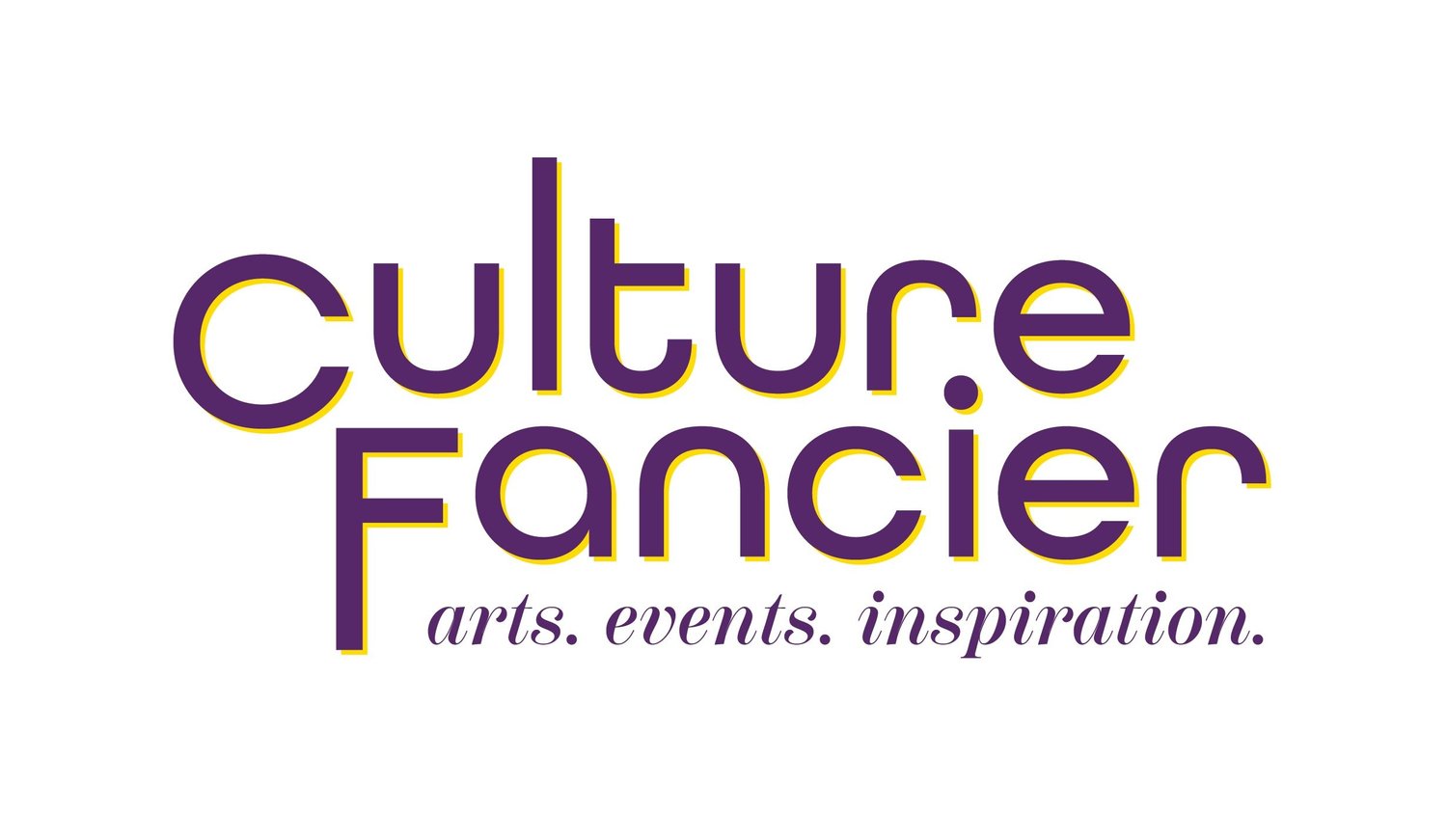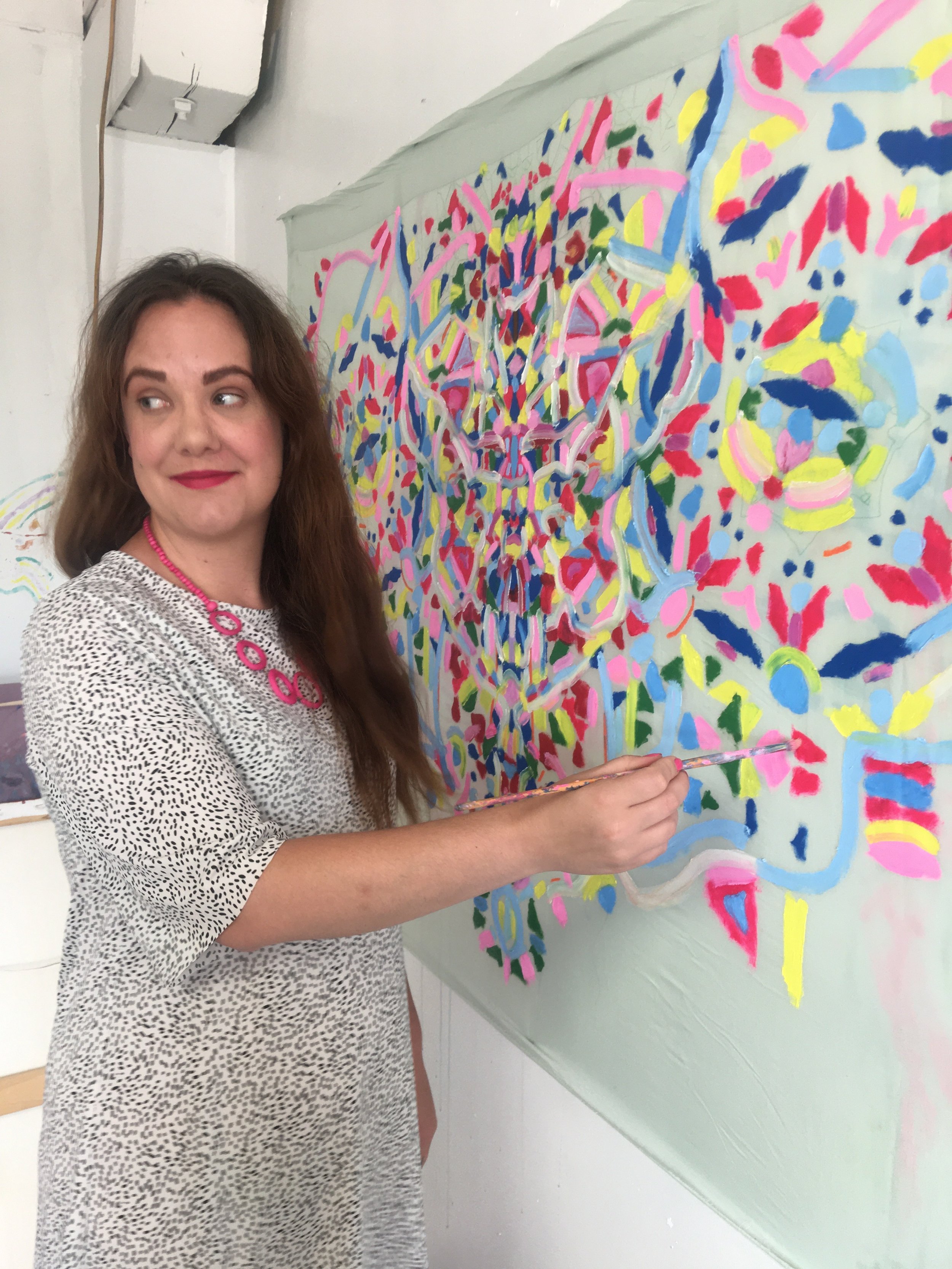Christina MacLellan has been painting and drawing avidly for over fifteen years. She lives in Waterloo, Ontario.
As Guest Curator at Minds Eye Studio Art Gallery and Yoga Studio, I am pleased to present Bright As Day, a solo exhibition of Christina’s work at the gallery from June 26th to July 30th. Private viewings are available and the artist reception will be on July 28th from 7:30-10 pm. Event info is here.
Artist Statement: My interests in art making began as a kind of cathartic release from mental and emotional turmoil. After beginning my practice by drawing portraits, I soon expanded my work into abstract art. I attended Ontario College of Art and Design University. It took me 8 years to graduate because of mental health issues, including hospitalizations from psychotic breakdowns. My experiences of being mentally ill greatly influence my work. From the bright colours that mirror hallucination, to the subject of the face and figure my work is heavily related to my illness. My diagnosis of schizophrenia comes with heavy stigma. It’s important to me to work against that stigma. Mentally ill folks, schizophrenic folks, can and do contribute to society in positive ways. My work as an artist is an example of the transformative powers of art and expression. People need to see that recovery is possible as well as how essential a supportive community is for someone living with mental illness. I hope to inspire those who see my work to reconsider their ideas about schizophrenia.
Exhibition Statement: Although it seems at times as if the clouds will never part, there is always a chance for recovery. Just as the darkness of night will always be greeted by the light of day, we also can see the light within the darkness. You may be in pain, but just as dawn will always come, growth is inevitable. Things can change. Healing is possible. My hope for us all is to lead a life that is not so dark, but Bright As Day. This exhibition encompasses a variety of work by Christina MacLellan. She uses bright colours to depict portrait, figurative and abstract works of art. Although Christina struggles with mental illness she remains optimistic. Her work is heavily informed by her experiences being mentally ill. The bright colours of her work are intentional. There’s something therapeutic about working with bright colours. Staring at colours for hours potentially improves ones mood as well as improving ones mental habitat. Please enjoy this exhibit. Sometimes we feel dark as night, but Christina hopes when you look at her work you will feel the clouds part to reveal some light and colour.
“Art is certainly healing and can be a way of transforming trauma and violence. I really believe that.”
You intentionally use bright colours in your work. What is your favourite colour to work with and why?
My favourite colour to work with is bright pink. I often pair bright pink with blue to create a contrast and balance within the work. The bright colours I use are inspired by various experiences I have had seeing colours that are hallucinatory. These colours are extremely bright and not typically viewed in a normal spectrum.
I also find using bright colours, like fluorescent pink, to be therapeutic. I might spend hours and hours on a piece and staring at bright colours I find can improve my mood and overall well being.
What is your creative process for painting?
I tend to paint in a variety of different ways. Abstractly, figuratively, painting portraits or working with symmetry. The process for each of these styles begins spontaneously. With abstraction, I work within the push and pull of creating an image that is aesthetically pleasing and attempting to work against just a pretty image. Working figuratively is parallel to that process. I try to make the figures beautiful, and then ugly, raw and then detailed.
I also make pieces of freehand symmetry. The process for making symmetrical images is all about getting in the flow and sort of meditating.
I would say that the majority of my work taps images and ideas related to my journey of healing from mental illness. The source of some pieces, especially symmetrical pieces, originated while I was hospitalized with postpartum psychosis.
I love to work on a large scale. I am lucky to be hardly ever intimidated by a large surface. In fact, a large surface inspires me. I also love being in a flow state. Unaware of the hours passing by while I am painting or drawing. I keep going back to that feeling all the time.
Has your creative process changed from when you first started making art to now?
My process has evolved. I began painting as a means to transform mental and emotional pain. I needed a distraction. I would try to copy images of icons I look up to, to make portraits of them. I then began to work abstractly.
While at art school, I was exposed to a lot of different ideas about art. My practice really grew as a result. The broadness of art making is fascinating. At school, I experimented with performance art as well as sculpture and installation. It is challenging to remain as supported and inspired as being in an academic art environment. Yet, the influences from my time at school remain.
I hope to continue to expand my art practice. I need to remember the importance of research and brainstorming and note making.
I tend to make quick notes before figurative works. I write down around ten to twenty words that I relate to as symbols. Words like - bird, sword, scissors. Then as I create the work I refer to the list. Creating images for each word. That would be a small example of my process today.
Are the faces and figures in your work representative of you or anyone that you know?
In terms of painting portraits, the faces and figures in my work are sometimes me, sometimes imaginary and sometimes I use a reference photo I find online, an obscure model or someone. I also often try to paint faces from memory without a reference. Again, this process involves spontaneity and intuition.
You’re also a writer. Can you talk about your writing process and inspiration?
My writing process mirrors my painting process. It is extremely spontaneous. My writing is often stream of consciousness. My painting is prolific and my writing is as well. I write in various ways, poetry, memoir and fiction mainly. Depending on the project, I have a different way of working. Similar to a a blank canvas, I am rarely intimidated by a blank page. I tend to work quickly, with painting or with writing. With writing, I make many handwritten notes throughout the project, especially with fiction. I am currently working on a novel and have a book of poetry I have completed.
What is your dream creative project?
I am hoping to work within my community as a healing artist. I would like to mentor mentally ill artists. My dream creative project would be to open a gallery or store that displays and sells the works of mentally ill or marginalized artists.
Art is certainly healing and can be a way of transforming trauma and violence. I really believe that.
In terms of creative projects within my own practice…I think I have a long way to go. And I’ve come a long way. I’m not sure which direction I will go in. I am interested in working on a very large scale. I’m interested in visual art, writing and performance. Finding where those ways of creating intersect is the direction I want to go in. But I really don’t know a precise project at this time. Although,I’m excited to see where art takes me.
In your artist statement you talked about dispelling stigmas that come with your diagnosis. Has your work ever been perceived in a different way after a viewer knows about your diagnosis?
I think, depending on the person my diagnosis is either an entry point to the work or a means for disregarding the art. Sometimes, being open about mental illness can lead to wonderful, heartfelt conversations. And sometimes, viewers are freaked out by it and want to leave. It’s one of those things where you either “get it” or you don’t. I think it depends on the viewers own experiences with knowing people who have mental illness
Do you have any words of advice for anyone embarking on their own transformation through artistic expression?
Of course! Keep going, don’t give up. Don’t worry about the outcome, enjoy the process. Experiment and try new things. Take breaks and don’t put pressure on yourself. Enjoy, and work and have fun!
Follow Christina on Instagram
Interview by Glodeane Brown
If you liked this post please like, comment, and share.


